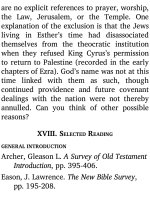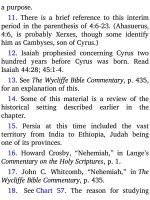Jensens survey of the old testament adam 627
Bạn đang xem bản rút gọn của tài liệu. Xem và tải ngay bản đầy đủ của tài liệu tại đây (209.26 KB, 4 trang )
Jensen, Irving L. Revelation. A Self-Study
Guide.
Payne, J. Barton. Encyclopedia of Biblical
Prophecy.
Pentecost, J. Dwight. Prophecy for Today.
Sauer, Erich. From Eternity to Eternity.
Smith, Wilbur M. The Biblical Doctrine of
Heaven.
Tenney, Merrill C. Interpreting Revelation.
1. For a very informative discussion of the
status of Judaism and Christianity in the
Roman Empire when Revelation was
written, consult Merrill C. Tenney,
Interpreting Revelation, pp. 20-27.
2. The worst persecution was yet to come
for Christians, when John wrote Revelation.
This made the ominous message of
Revelation all the more relevant.
3. In the Greek, the genitive “of Jesus
Christ” in 1:1 is either an objective genitive
(i.e., Jesus is the one revealed) or a
subjective genitive (i.e., Jesus is the one
revealing). The intention of the passage is
probably both, that is, revelation about
Christ and revelation from Christ.
4. Wilbur M. Smith, “Revelation,” in The
Wycliffe Bible Commentary, p. 1492.
5. Other apocalyptic books of the Bible are
Daniel, Ezekiel, and Zechariah. Because
Revelation’s apocalyptic form made it so
di erent from the other New Testament
books, there was delay in this book’s being
accepted as canonical by the Eastern
church. The Western church, however, early
recognized Revelation’s divine inspiration.
6. In many ways Revelation di ers from
noncanonical apocalyptic writings, such as
in its overall optimism, moral urgency, and
identification of authorship.
7. See Wilbur M. Smith, A Treasury of Books
for Bible Study, pp. 235-42, for an extensive
comparative study of the two scriptures.
8. The NASB identi es most of the songs by
setting them in indented and blocked form
(e.g., 4:11).
9. Merrill C. Tenney, Interpreting Revelation,
p. 33. Such an outline is arrived at in the
later, more advanced stages of survey study.
10. Chart 128 shows the view of a midtribulation rapture (dashed line). There is
also a posttribulation view that places the
rapture at the end of the Tribulation,
followed immediately by Christ’s return to
the earth.
11. John F. Walvoord, The Revelation of
Jesus Christ, p. 103. Walvoord’s reference to
“second coming” here is to Christ’s return to
the earth (19:11-21), which is a key event of
Revelation.









